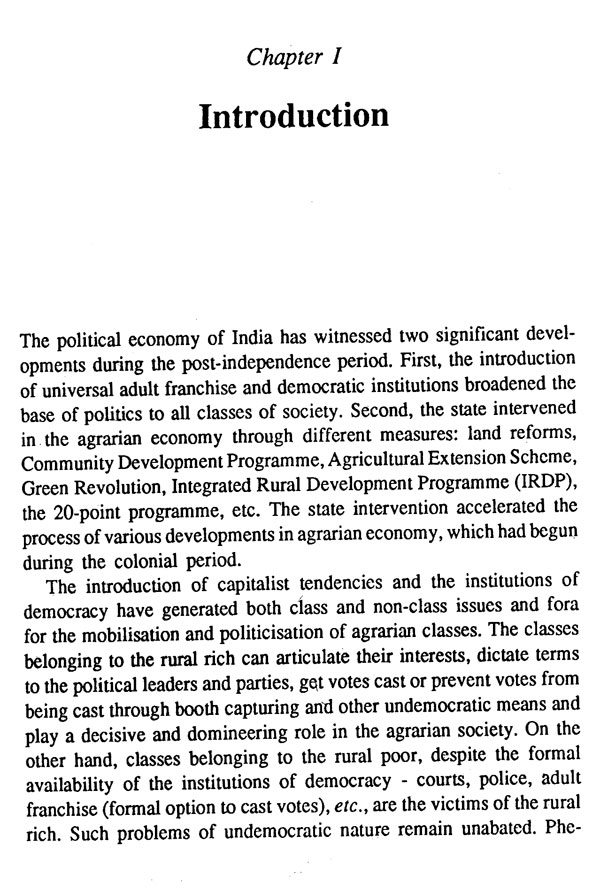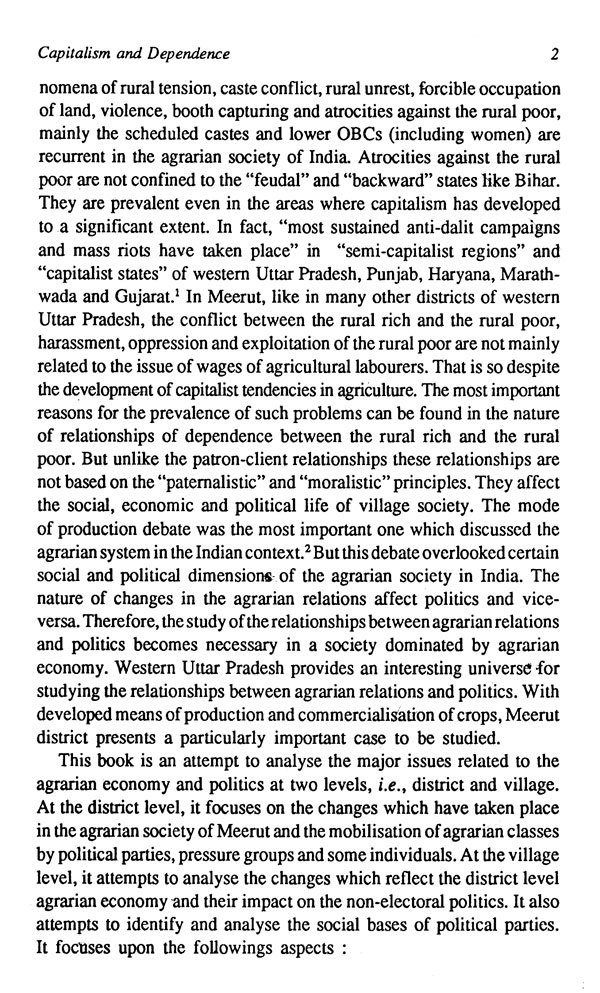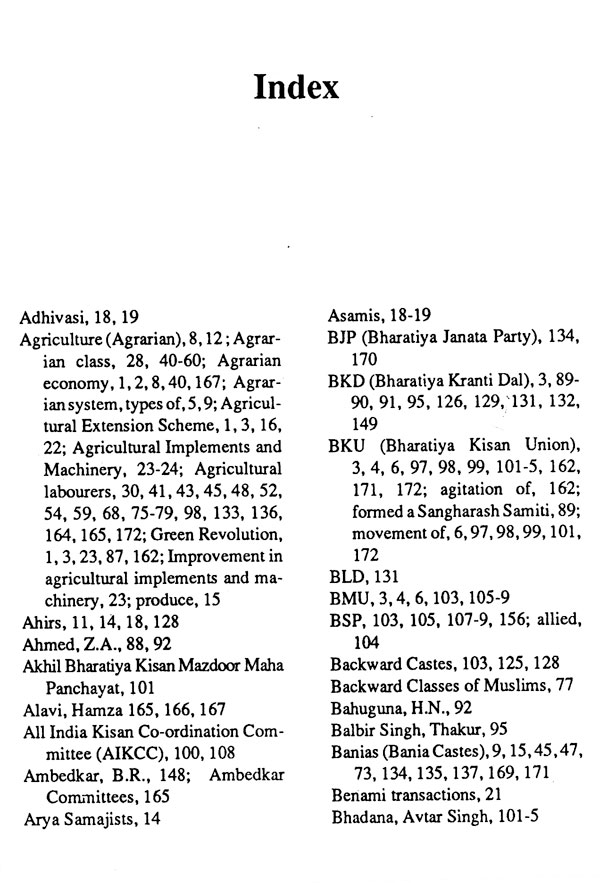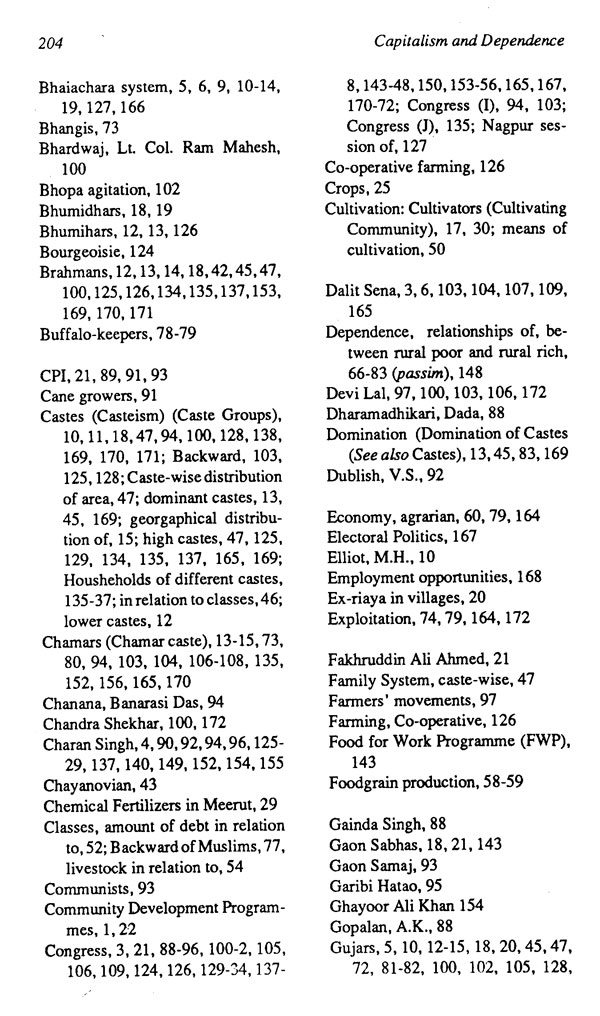
Capitalism and Dependence - Agrarian Politics in Western Uttar Pradesh (1951-1991)
Book Specification
| Item Code: | NAZ764 |
| Author: | Jagpal Singh |
| Publisher: | Manohar Publishers and Distributors |
| Language: | English |
| Edition: | 1992 |
| ISBN: | 8173040265 |
| Pages: | 228 |
| Cover: | HARDCOVER |
| Other Details | 8.50 X 5.50 inch |
| Weight | 370 gm |
Book Description
The post independence period has witnessed two significant developments in the political economy of India. The introduction of universal adult franchise has broadened the base of politics and made every section of agrarian society an inalienable part of the political process. State intervention through different measures has accelerated the process of various developments in agrarian economy which had begun during the colonial period. In the emerging situation different castes, classes and groups started organising themselves with a view to furthering their interests and carve out a dominant place for themselves in political, economic and social fields etc.
The 1970s and 1980s witnessed assertion by commercial farmers (landlords, rich and middle peasants) through agitation by BKU, Shetkari Sanghatka Rajaya Raitha Sangha and Vivasayingal Sangham in various regions. of the country giving rise to the development of capitalist tendencies and the relationship of dependence. In the event the rural poor despite the formal availability of institutions of democracy continue to be the victims of the rural rich.
Given the above framework, this study seeks to analyse major issues relating to the agrarian economy and politics. It focuses on changes in the 'agrarian society and the mobilisation of agrarian classes by political parties, pressure groups and individuals. It also attempts to identify the social bases of political parties. The data has been drawn from field studies carried out in western UP which provides an interesting universe for studying the problems with its developed means of production and commercialisation of crops. The study also discusses recent trends of communalisation and Hinduisation of agrarian classes.
It is an inter disciplinary work which should interest students of Political Science, Rural Sociology and Agrarian Economy and all those interested in understanding the changing rural scenario in India.
Jagpal Singh bolds a Ph. D. from the Centre for Political Studies, Jawaharlal Nehru University, New Delhi. He has taught at Dyal Singh College, University of Delhi, and has been a consultant in the Department of Political Science, Indira Gandhi National Open University, New Delhi. Presently he is a lecturer in Political Science in the North-Eastern Hill University (NEHU) Shillong. He is involved in research on issues relating to state-society relationship and democracy in India.
This book is an attempt to analyse the relationships between the changing agrarian relations and politics in Meerut district of western Uttar Pradesh from 1951 to 1991. The book is a thoroughly revised version of my Ph.D. thesis submitted at Jawaharlal Nehru University (JNU), New Delhi, in 1988. The period following the field-work for Ph.D. in 1984-85 was marked by certain significant developments in western Uttar Pradesh. The Bharatiya Kisan Union (BKU) emerged as a force in 1986/ 87 and it drew nation-wide attention. Almost at the same time, the Bharatiya Mazdoor Union (BMU), Dalit Sena and Shoshit Mukti Vahini also emerged. In 1990-91, the Bharatiya Janata Party (BJP) emerged as a force to reckon with in the villages of western Uttar Pradesh. The BKU mobilised the market-oriented peasantry and the BMU/the Dalit Sena/the Shoshit Mukti Vahini mobilised the rural poor, mainly be-longing to the Chamar caste. Their activities became more intense from 1988 onwards. The BJP mobilised almost all agrarian classes belonging to the Hindus on the issues pertaining to the Ayodhya dispute in the 1991 general election. The BKU, the BMU/the Dalit Sena/the Shoshit Mukti Vahini and their activities and post-Ayodhya developments could not form part of the Ph.D. thesis. The book is an improvement in that it is updated to include these recent developments and the conclusion has been written afresh. In addition, changes to varying degrees have been made in all chapters. The postscript has been written to cover the post-Ayodhya developments.
Book’s Content and Sample Pages














